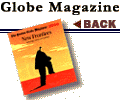The F2F challenge
Can a body meet a body coming through the wire?
By Chet Raymo
There is a now-famous New Yorker cartoon by Peter Steiner that has come to define the age of electronic communication. It shows two dogs sitting in front of a computer. One pooch says to the other: ''On the Internet, no one knows you're a dog.''
As we move into the decade, century, and millennium of Y2K+, what will become of face to face, or, in the language of cyberspeak, F2F? Does it matter that no one knows you're a dog?
All those places contrived by humankind for social commerce - the agora, the bazaar, the cafe, the gallery, the concert hall, the theater, the classroom, the double bed - have been cyberized. We work from home or from airplanes at 30,000 feet. We buy books, cars, airplane tickets, on line. We troll for dates in chat rooms, court by e-mail, consummate relationships with cell-phone sex. The corner newsstand has been replaced by a fiber-optic thread that pumps into our monitors more news than we can ever hope to assimilate. It's hard to think of any human need that cannot be met digitally. A shoeshine? Walking the dog? A coronary bypass?
Is the cyber revolution the salvation of humankind, as some digerati proclaim? Or is it the end of everything good that proceeds from face-to-face flesh and blood, as cyber Luddites insist? The battle lines are drawn between the pundits, the fray engaged. And all, of course, to no avail. There can be no turning back. We will be swept down the information highway into a world not yet fully imagined, whether we wish it or not.
We have faced these unsettling forces before. A hundred years ago, it was the telephone, which Scientific American magazine then saw as ''nothing less than a new organization of society - a state of things in which every individual, however secluded, will have at call every other individual in the community, to the saving of no end of social and business complications, of needless goings to and fro.''
Another pundit of the time proclaimed an ''epoch of neighborship without propinquity.''
But in spite of proclamations to the contrary, the telephone did not mean the end of F2F, and neither will wireless cell phones or the World Wide Web. ''Only the most hopelessly nerded-out technogeeks could be persuaded to trade the joys of direct human interaction for solitary play with their laptops in darkened rooms,'' says MIT media guru William Mitchell, and, of course, he is absolutely right. For most of us, the cyber age simply means more control over when and where we go face to face.
The advantage of Web-based communication is propinquity without neighborship. That is to say, for the first time, we are able as a species to establish social alliances that are not limited to our physical neighborhoods, which have generally been segregated by caste, class, ethnic, racial or religious identity, or socioeconomic circumstances. On the Internet, no one knows if you are a prince or a pauper, black or white, Serb or Albanian, Protestant or Catholic. Folks fall into relationships based on a broader spectrum of affinities, which may include any of the above.
This universal sharing of cultural experience means that many vernaculars will be lost as living cultural traditions, but by establishing virtual relationships around the globe, we may be less likely to expend our energy killing one another over real or perceived differences. There will be haves and have-nots on the World Wide Web, defined by available bandwidth - how many bits per second spew onto your screen - but there won't be a Balkans, a Northern Ireland, a West Bank.
The anthropologist Margaret Mead once said that civilization is the ever-widening circle of those whom we do not kill. The World Wide Web is the widest circle of all, and a marginal loss of F2F is a small price to pay for recognition that we are all one folk in cyberspace.
Long before the Internet, the Jesuit scientist and theologian Teilhard de Chardin imagined that the natural evolution of the biosphere would lead to something he called the Noosphere, a disembodied intelligence that wraps the planet. Today, the Noosphere is exploding all about us, except we call it the Internet.
''Like a force of nature, the digital age cannot be denied or stopped,'' writes Nicholas Negroponte, another MIT media guru. ''It has four very powerful qualities that will result in its ultimate triumph,'' he says. It is ''decentralizing, globalizing, harmonizing, and empowering.''
For better or worse - and I think for better - the Age of F2F is winding down. Protoplasm will be less and less important in global culture. On the local scale, we'll still go eye-to-eye, hold hands, mush lips, make babies in double beds; but a new, global electronic organism is in the making, of which our individual minds will be like cells in a body.
The Internet stitches thoughts together at the speed of light, in a web too complex for anyone - or any clique - to control, crackling with creative energy, sweeping up pell-mell toward Teilhard's vaguely visualized Noosphere, now seen as an infinite planetary overlay of bodiless bits.
My 86-year-old mother just came on line. She brought six kids into the world, and they soon dispersed all over the country, leaving her alone in the old hometown. She's too frail to make it to the snail-mail box more than once or twice a week. The phone is hopelessly one-dimensional. But now she can point and click her way into family photograph albums, read this essay on-screen, get e-mails from digitally literate grandkids who would never lick a stamp. It may not be F2F, but under the circumstances, it has its own empowering intimacy.
Chet Raymo teaches at Stonehill College in North Easton. His most recent book is Skeptics and True Believers: The Exhilarating Connection Between Science and Religion.
|



![]()
![]()




